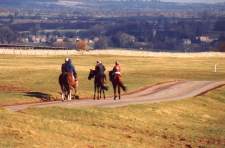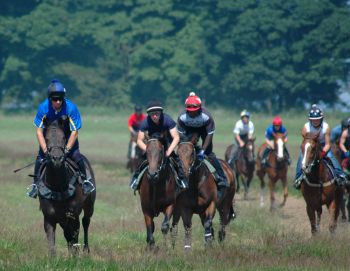| Year |
Event |
| 1537 |
Sir Arthur Darcy writes to King Henry VIII
recommending that he make use of the stud at Jervaulx
saying "....... should have there the most best
pasture that should be in England, hard and sound of
kind. For assuredly the breed of Jervaulx for horses was
the tried breed of the north ; the stallions and mares so
well sorted that I think in no realm should we find the
like of them". |
| 1595 |
A racecourse first appears on a map of Doncaster
Town Moor. |
| 1619 |
At Kiplingcotes the earliest known
rules of racing are drawn up. This race the 'Kiplingcotes
Derby' is still run today, although it is not run under
Jockey Club rules and most closely resembles a
point-to-point, without the fences. The race reputedly
actually began in 1555, although records only exist from
1619 onwards. The race is run on the third Thursday in
March and involves locals challenging each other to race
from Etton nr. Beverely to Middleton-On -The-Wolds, a
distance of about four miles. |
| 1648 |
James D'Arcy of Sebury Stud, Bedale takes
the 'Sedbury Royal Mare' (family number 13) from his
father's stud at Hornby Castle (between Bedale and
Catterick). Her notable descendants
include Highflyer, Pharos, Plassy, Ferdinand, Darshaan,
Tourbillon, Seattle Slew, Mr.Prospector, and Princely
Gift. 
Hornby Castle, click for a larger image
|
| 1655 |
The old Bald Peg mare, based at Helmsley,
produces a mare who later was dam of Spanker. This is
family number 6 and has produced Diomed, Hyperion, Big
Game, Grey Sovereign, Count Fleet, Mossborough, Snow
Knight, Fair Trial and Tenerani. |
| 1680 |
The mare 'Bustler Mare' (family number 8) was known
to be based at Mr.Huttons stud at Marske, Nr.Richmond
at this time. Her descendants include Marske, Nijinsky,
El Gran Senor, Raise A Native, Grundy, Red God, Ruffian,
Icecapade, Majestic Light, Menow, Heliopolis, Sir Ivor,
Sassafras, Shantung, Damascus, Whirlaway, Zilzal and Bold
Ruler. |
| |
Another original mare based at Marske was 'Hutton's
Old Spot Mare' (family number 16) her descendants include
Ormonde, Sceptre, Bahram, Bois Roussel, Crepello, Holy
Bull, Desmond, Green Dancer, Herbager, Slip Anchor,
Steinlen, Bulldog, Fappiiano, Dastur and Hard Ridden. |
| 1670s |
King Charles II commissions James D'Arcy, the master
of the Royal Studs, to supply him with "twelve
extra-ordinary good colts' for a fee of £800 per year
from his Sedbury Stud near Bedale. The
King bred very few horses himself and the 'Royal Mares'
mentioned in early General Stud Books were probably just
the mares D'Arcy used to supply the King with horses,
some of these are listed below: |
| |
One of these mares based at Sedbury was 'Lord Darcy's
Blacklegs Royal Mare' (family number 7) and her
descendants include West Australian, Persimmon, Sicambre,
Le Levanstell, Pall Mall, Caergwrle, Mieuxce, Rockefella,
Kampala, Danzig, Jim French and Serena's Song. |
| |
Another such mare was 'Sedbury Royal Mare' (family
number 11) whose descendants include Birdcatcher,
Sr.Simon, Orme, High Top, Nunthorpe, War Admiral, Stop
The Music, Zeddaan, Thunder Gulch, Gummo and Hill Gail. |
| |
Another 'Sedbury Royal Mare' formed family number 12
and her descendants include Eclipse, Cox's Ridge,
Roberto, Rialto, The Bard, Lexington and Voltaire. |
| 1685 |
The 'Layton Barb Mare' was born at the Sedbury Stud, Bedale.
This is mare family number 4 and notable descendants
include Matchem, Apology, Nearco, Man O'War, Ribot,
Habitat, Ribero, Graustark, His Majesty, Majestic Prince,
Boldnesian, Hail To Reason, Triptych, Ile de Bourbon,
Storm Bird and Balanchine. |
| 1687 |
The stallion Byerley Turk is captured by Captain
Byerley, after using him as a saddlehorse he was sent to
stud first a Middridge Grange in Co.Durham and later at
Goldsborough Hall, York. Through his son
Jigg, this sireline is responsible for the likes of
Tourbillon and The Tetrarch. Goldsborough was later used
as a stud by Lord Harewood,
and then became a nursing home, in September 2003 however
it was put up for sale, along with 10 acres of parkland. |
| 1690 |
Beverley races are started on the
area known as The Westwood, some 1,174 acres of common
land. |
| 1704 |
Thomas Darley, sends the Darley Arabian to his home
at Aldby Park, Buttercrambe, Nr.York from
Syria. Foaled in 1700 he stood at Aldby Park throughout
his career, and died aged 30. Through his sons the own
brothers Flying Childers and, more signficantly,
Barlett's Childers 90% of the world's bloodstock can be
traced back to this stallion, far outnumbering the
Godolphin Arabian (who reputedly also stood for some time
near Bedale), and the aforementioned Byerley Turk. Indeed
recent research shows that in 95% of
thoroughbreds the 'Y' chromosome can be traced back to
the Darley Arabian. |
| 1708 |
Daniel Defoe in his 'Tour of Great Britain' recorded
that "the country round Bedale, indeed the whole
county, is more or less full of jockeys and dealers in
horses, and the breed in this and the next county is so
well known that, though the pedigree of them is not
preserved as in Arabia, yet are their stallions
denominated by name that never fails to advance the price
according to the reputation of the sire. Let foreigners
boast as they will of Barb and Turkish horses, I believe
that some of the gallopers of this county and the
Bishoprick of Durham will out-do for speed and strength
the swiftest horse that was ever bred in Turkey or
Barbary.". |
| 1709 |
York holds the first fully reported
race meeting. The victory of Wart (owned by Thomas
Metcalfe of Northallerton) in the Gold Cup being the
first recorded entry in the Racing Calendar. |
| 1714 |
Leonard Childers of Cantley Hall, Doncaster bred
the famous Flying Childers, although the horse was later
sold to the Duke of Devonshire. He was never beaten and
is still regarded as one of the fastest horses ever
raced. He later retired to Chatsworth, Derbyshire
although he mainly covered mares owned by the Duke, as he
was too far away from the main breeding centre of
Yorkshire. |
| |
Flying Childer's own brother Bartlett's Childers was
the more successful stallion and stood at his owners
Nuttle Court, nr.Masham. Being available
to Yorkshire breeders he stood a much better chance at
stud and sired a good many winners, the most important of
which was Squirt, see below. |
| |
Marske, a grandson of Bartlett's Childers (via
Squirt), was foaled at the village of the same name near Richmond.
He was later to be the sire of the great Eclipse. |
| 1723 |
What was probably the world's first horse race for
Lady Jockey's is run at Ripon. |
| 1731 |
Racing in York is transferred to
it's current home, the Knavesmire, having previously been
held at Rawcliffe Ings and the Forest Galtres. The first
meeting was held on the 16th August and lasted for six
days. |
| 1731 |
Bedale stages the first race for
three-year-olds. |
| 1735 |
The Chaplain to the Earl of Oxford recorded in his
diary, after a visit to Hambleton and Richmond, "In
this part of the country the best horses are said to be
bred, and everybody here is born a jockey, and any
stranger may soon be furnished with all the cant and
trick belonging to the way of trading". |
| 1738 |
The first recognised racing is held at Pontefract. |
| 1739 |
Middleham has a racecourse laid out
on the High Moor. This outline of the course is still
used as gallops to this day. There was a Crown course (5
furlongs and 88 yds) and a Gold Cup course (3 miles), as
well as the two mile course. 
Middleham High Moor, July 2005, is
there a better place in the world to train racehorses?!?
Click for a larger image.
|
| 1740 |
An Act of parliament is passed decreeing that racing
can only take place at Hambleton (where
Bryan Smart and Kevin Ryan now train), York and
Newmarket. Thus two out of the three official racecourses
in the country were in Yorkshire. |
| 1752 (or 53) |
Sir Charles Turner of Kirkleatham ran a match for
1,000 Guineas with the Earl Of March that he could ride
ten miles across country near Richmond, taking in 40
fences within an hour. He covered the distance (and
jumps) in a mere 35 minutes. Arguably this was one of the
first ever steeplechases. |
| 1760 |
Gimcrack (after whom the race at York
is known) was foaled, he was later known as "The
Wonder of the North" and didn't retire to stud until
1771. |
| 1765 |
Issac Cape becomes the first professional trainer to
base himself in the Middleham area (at
Tupgill Park where Edward Bethell now trains). 
Horses returning from Middleham Low Moor, click for a
larger image
|
| 1766 |
The Doncaster Cup is run for the
first time, being the course's oldest present day race. |
| 1767 |
'The Ancient Fraternitie of Gimcracks' aka The
Gimcrack Club is formed. This was an annual gathering of
racing supporters and the club was named after the famous
horse of the day. When the Gimcrack race was started in
1846 the club began the tradition that guests were
invited to listen to a speech by the winning owner. This
tradition continues to this day, and the speech is
frequently an important barometer on the state of British
racing. |
| 1773 |
Despite the 1740 act the first Racing Calendar lists
races at Kiplingcotes, Beverley, Scarborough,
Richmond, Sheffield, Wakefield, Doncaster, Boroughbridge,
Northallerton and Malton as well as at Hambleton
and York. |
| 1774 |
The famous 'Aske Spots' colours of the Dundas/Zetland
family (of Aske Hall,
near Richmond) are registered for the
first time. |
| 1775 |
The historic Hambleton racecourse
closes down, although it is still used to this day as a
training centre. 
Horses work on Hambleton Gallops, July 2005, click for a
larger image
|
| 1775 |
£1,200 is raised by public subscription to build the
grandstand at Richmond Racecourse, part
of which still stands today. |
| 1776 |
First running at Doncaster of the
sweepstakes that became, two years later, the St.Leger -
the worlds oldest classic race. |
| 1780 |
Ruler, trained at Middleham by
J.Mangle (and also ridden by him!) wins the St.Leger.
Ruler was owned by the Bethell family, who are still
involved in Middleham racing to this day. |
| 1783 |
The first recorded race meeting at Catterick.
This was held on what was then the parkland of the
magnificent Brough Hall, which is now on the otherside of
the A1! Possibly therefore this original meeting was
slightly nearer the hall than the current course. A
permanent site was not built until 1813. |
| 1783 |
Phoenomenon, trained at Middleham by
Issac Cape, wins the St.Leger |
| 1786 |
Paragon, trained at Middleham by
J.Mangle (and also ridden by him!), wins the St.Leger |
| 1787 |
Spadille, trained at Middleham by
J.Mangle (and also ridden by him!), wins the St.Leger |
| 1788 |
Young Flora, trained at Middleham by
J.Mangle (and also ridden by him!), wins the St.Leger |
| 1791 |
Of the 70 'proper' mothers listed in the earliest
stud book, 65 are based in Yorkshire - mainly in the
Bedale/Masham area. |
| 1791 |
A race with the same conditions as The Park Hill
Stakes is run for the first time at Doncaster,
although it was originally known as the 'The Filly
Stakes' and the present name (and a matching increase in
prize money) wasn't bestowed upon the race until 1839. |
| 1792 |
Tartar, trained at Middleham by
J.Mangle (and also ridden by him!), wins the St.Leger |



